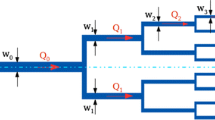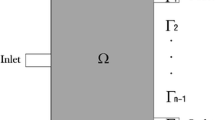Abstract
From the earliest of times, Man has sought to replicate ideas that have evolved naturally in plants and animals. Understanding and extracting these “natural” design strategies has opened up a whole new field of research known as biomimetics. Designs formulated using biologically inspired principles range from novel surface treatments that mimic physiological processes to geometrical optimization for improving the performance of a system. In this paper, we will show how biomimetic principles based on the laws that govern biological vascular trees can be used to design artificial microfluidic distribution systems. The study focuses specifically on microfluidic manifolds composed of constant-depth rectangular- or trapezoidal-sectioned channels, as these geometries can readily be fabricated using standard micro-fabrication techniques. We will show that it is possible to introduce a prescribed element of flow control into the system by carefully selecting the branching parameter that governs the change in channel dimension at each bifurcation.








Similar content being viewed by others
References
Alharbi AY, Pence DV, Cullion RN (2003) Fluid flow through microscale fractal-like branching channel networks. J Fluids Eng 125:1051–1057
Alharbi AY, Pence DV, Cullion RN (2004) Thermal characteristics of microscale fractal-like branching channels. J Heat Transf 126:744–752
Atencia J, Beebe DJ (2004) Magnetically-driven biomimetic micro pumping using vortices. Lab Chip 4:598–602
Auniņš JG, Bader B, Caola A, Griffiths J, Katz M, Licari P, Ram K, Ranucci CS, Zhou W (2003) Fluid mechanics, cell distribution, and environment in cellcube bioreactors. Biotechnol Prog 19:2–8
Banavar JR, Maritan A, Rinaldo A (1999) Size and form in efficient transportation networks. Nature 399:130–132
Banavar JR, Damuth J, Maritan A, Rinaldo A (2002) Modelling universality and scaling. Nature 420:626–627
Barber RW, Cieślicki K, Emerson DR (2006) Using Murray’s law to design artificial vascular microfluidic networks. In: Design and Nature III: Comparing design in nature with science and engineering. WIT Press, Southampton, pp 245–254
Bar-Cohen Y (2003) Biologically inspired intelligent robots using artificial muscles (keynote presentation). In: International conference on MEMS, NANO, and Smart Systems, Banff
Bejan A (2000) Shape and structure, from engineering to nature. Cambridge University Press, Cambridge
Bejan A (2005) The constructal law of organization in nature: tree-shaped flows and body size. J Exp Biol 208:1677–1686
Bejan A, Lorente S (2006) Constructal theory of generation of configuration in nature and engineering. J Appl Phys 100:041301
Bohn S, Magnasco MO (2006) Structure, scaling and phase transition in the optimal transport network. Condensed Matter 0607819
CFD-ACE+ User Manual (2006) ESI CFD, Huntsville, USA
Chang WC, Lee LP, Liepmann D (2005) Biomimetic technique for adhesion-based collection and separation of cells in a microfluidic channel. Lab Chip 5:64–73
Chen Y, Cheng P (2002) Heat transfer and pressure drop in fractal tree-like microchannel nets. Int J Heat Mass Transf 45:2643–2648
Chen Y, Cheng P (2005) An experimental investigation on the thermal efficiency of fractal tree-like microchannel nets. Int Commun Heat Mass Transf 32:931–938
Cieślicki K (1999) Resistance to the blood flow of a vascular tree–a model study. Polish J Med Phys Eng 5:161–172
Conn AT, Burgess SC, Hyde RA (2006) Development of a novel flapping mechanism with adjustable wing kinematics for micro air vehicles. In: Design and Nature III: Comparing design in nature with science and engineering. WIT Press, Southampton, pp 277–286
Couder Y, Pauchard L, Allain C, Adda-Bedia M, Douady S (2002) The leaf venation as formed in a tensorial field. Euro Phys J B 28:135–138
Dan N, Bejan A (1998) Constructal tree networks for the time-dependent discharge of a finite-size volume to one point. J Appl Phys 84:3042–3050
Dertinger SKW, Chiu DT, Jeon NL, Whitesides GM (2001) Generation of gradients having complex shapes using microfluidic networks. Anal Chem 73:1240–1246
Durand M (2006) Architecture of optimal transport networks. Phys Rev E 73:016116
Emerson DR, Cieślicki K, Gu XJ, Barber RW (2006a) Biomimetic design of microfluidic manifolds based on a generalised Murray’s law. Lab Chip 6:447–454
Emerson DR, Cieślicki K, Barber RW (2006b) Hydrodynamic scaling approaches for the biomimetic design of microfluidic channels. In: ASME 4th International Conference on Nanochannels, Microchannels and Minichannels, Limerick. Paper no. ICNMM2006-96196
Ghodoossi L (2005) Thermal and hydrodynamic analysis of a fractal microchannel network. Energy Conv Manage 46:771–788
Hinman MB, Jones JA, Lewis RV (2000) Synthetic spider silk: a modular fiber. Trends Biotechnol 18:374–379
Jones KD, Platzer MF (2006) Flapping-wing aerohydromechanics in nature and engineering. In: Design and Nature III: Comparing design in nature with science and engineering. WIT Press, Southampton, pp 3–11
Jones KD, Nakashima M, Bradshaw CJ, Papadopoulos J, Platzer MF (2004) On flow separation control by means of flapping wings. In: Bio-mechanisms of swimming and flying, chap 5. Springer, Tokyo
Klarbring A, Petersson J, Torstenfelt B, Karlsson M (2003) Topology optimization of flow networks. Comput Methods Appl Mech Eng 192:3909–3932
Lazaris A, Arcidiacono S, Huang Y, Zhou JF, Duguay F, Chretien N, Welsh EA, Soares JW, Karatzas CN (2002) Spider silk fibers spun from soluble recombinant silk produced in mammalian cells. Science 295:472–476
Ledezma GA, Bejan A, Errera MR (1997) Constructal tree networks for heat transfer. J Appl Phys 82:89–100
Lim D, Kamotani Y, Cho B, Mazumder J, Takayama S (2003) Fabrication of microfluidic mixers and artificial vasculatures using a high-brightness diode-pumped Nd:YAG laser direct write method. Lab Chip 3:318–323
Ma N, Koelling KW, Chalmers JJ (2002) Fabrication and use of a transient contractional flow device to quantify the sensitivity of mammalian and insect cells to hydrodynamic forces. Biotechnol Bioeng 80:428–437
Mattheck C, Sörensen J, Bethge K (2006) A graphic way for notch shape optimization. In: Design and Nature III: Comparing design in nature with science and engineering. WIT Press, Southampton, pp 13–21
McCulloh KA, Sperry JS, Adler FR (2003) Water transport in plants obeys Murray’s law. Nature 421:939–942
Moorthy J, Beebe DJ (2003) Organic and biomimetic designs for microfluidic systems. Anal Chem 75:292A–301A
Morini GL (2004) Laminar liquid flow through silicon microchannels. J Fluids Eng 126:485–489
Morini GL, Lorenzini M, Spiga M (2005) A criterion for experimental validation of slip-flow models for incompressible rarefied gases through microchannels. Microfluid Nanofluid 1:190–196
Murray CD (1926) The physiological principle of minimum work: I. The vascular system and the cost of blood volume. Proc Natl Acad Sci USA 12:207–214
Roth-Nebelsick A, Uhl D, Mosbrugger V, Kerp H (2001) Evolution and function of leaf venation architecture: a review. Ann Bot 87:553–566
Scherge M, Gorb SN (2000) Using biological principles to design MEMS. J Micromech Microeng 10:359–364
Senn SM, Poulikakos D (2004) Laminar mixing, heat transfer and pressure drop in tree-like microchannel nets and their application for thermal management in polymer electrolyte fuel cells. J Power Sources 130:178–191
Shah RK, London AL (1978) Laminar flow forced convection in ducts. Academic, New York
Sherman TF (1981) On connecting large vessels to small: the meaning of Murray’s law. J Gen Physiol 78:431–453
Shevkoplyas SS, Yoshida T, Munn LL, Bitensky MW (2005) Biomimetic design of a microfluidic device for auto-separation of leukocytes from whole blood. NSTI-Nanotech 1:183–186
Wechsatol W, Lorente S, Bejan A (2006) Tree-shaped flow structures with local junction losses. Int J Heat Mass Transf 49:2957–2964
West BJ (1990) Fractal physiology and chaos in medicine. World Scientific, Singapore
West GB (1999) The origin of universal scaling laws in biology. Physica A 263:104–113
West GB, Brown JH, Enquist BJ (1997) A general model for the origin of allometric scaling laws in biology. Science 276:122–126
White FM (1991) Viscous fluid flow, 2nd edn. McGraw-Hill, New York
Xu P, Yu B, Yun M, Zou M (2006) Heat conduction in fractal tree-like branched networks. Int J Heat Mass Transf 49:3746–3751
Zamir M (1976) The role of shear forces in arterial branching. J Gen Physiol 67:213–222
Zamir M (1977) Shear forces and blood vessel radii in the cardiovascular system. J Gen Physiol 69:449–461
Zhou Y, Kassab GS, Molloi S (1999) On the design of the coronary arterial tree: a generalization of Murray’s law. Phys Med Biol 44:2929–2945
Acknowledgments
The authors would like to acknowledge partial support from the Framework VI PATENT DfMM Network of Excellence (Contract no. 507255). Additional support was provided by the UK Engineering and Physical Sciences Research Council (EPSRC) under the auspices of Collaborative Computational Project 12 (CCP12). The authors would also like to thank Professor Krzysztof Cieślicki of Warsaw University of Technology for the many useful discussions on Murray’s law.
Author information
Authors and Affiliations
Corresponding author
Rights and permissions
About this article
Cite this article
Barber, R.W., Emerson, D.R. Optimal design of microfluidic networks using biologically inspired principles. Microfluid Nanofluid 4, 179–191 (2008). https://doi.org/10.1007/s10404-007-0163-6
Received:
Accepted:
Published:
Issue Date:
DOI: https://doi.org/10.1007/s10404-007-0163-6




